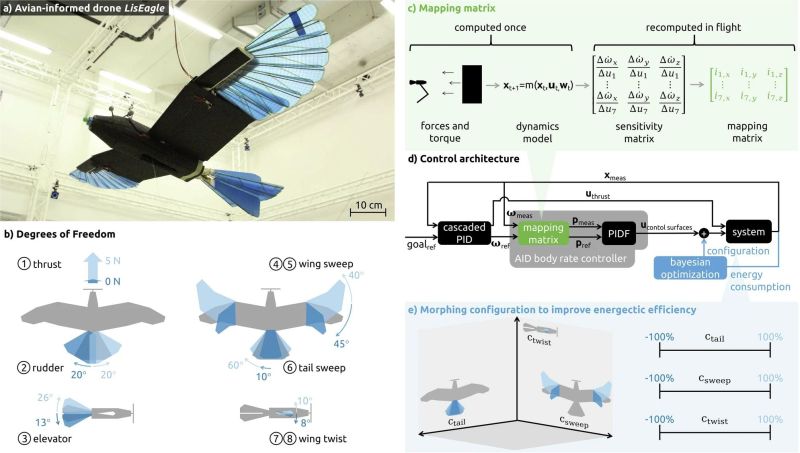
Throughout evolution, the concept of powered flight has evolved and refined itself multiple times across both dinosaurs (birds), mammals (bats) and insects. So why is it that our human-made flying machines are so unlike them? The field of nature-inspired flying drones is a lively one, but one that is filled with challenges. In a recent video on the Ziroth YouTube channel, [Ryan Inis] takes a look at these efforts, in particular those of EPFL, whose recent RAVEN drone we had a look at recently already.
Along with RAVEN, there is also another project (LisRaptor) based on the Northern Goshawk, a bird of prey seen in both Europe and North-America. While RAVEN mostly focused on the near-vertical take-off that smaller birds are capable of, this project studies the interactions between the bird’s wings and tail, and how these enable rapid changes to the bird’s flight trajectory and velocity, while maintaining efficiency.
The video provides a good overview of this project. Where the LisRaptor differs from the animal is in having a rudder and a propeller, but the former should ideally not be necessary. Obviously the kinematics behind controlled flight are not at all easy, and the researchers spent a lot of time running through configurations aided by machine learning to achieve the ideal – and most efficient – wing and tail configuration. As these prototypes progress, they may one day lead to drones that are hard to differentiate from birds and bats.
















Everyone knows Birds Aren’t Real – they’re just copying existing (and better) robots.
Just wait until version 2: birds with AI…and version 3: birds with AI and blockchain!
Non Fungible Titmouse
I lost it when the speaker called those “drones”.
Wish the speaker would stop going back to pictures of himself talking…
You don’t watch TV or YouTube much often do you?
Have we not come far along enough in flight control that we can forgo the vertical stabilizer? I’m no ornithologist but I can’t say Ive seen many birds so equipped.
Birds have thrust vectoring.
Actually, it’s not much a matter of thrust vectoring, which would be useless in a glide, but of a very fast “fly -by-wetware” control system coupled with complex control surface morphing, weight shifting and extremely relaxed stability. A bird controls pitch by shifting the aerodynamic center backward and forward, yaw and roll by altering the wing sweep and length, and can tilt and fan the tail at will in several directions. An albatross in a glide is a very high aspect ratio flying plank with a central pod, the tail does very little, but it’s still needed for taking off and landing and to recover from upsets.
This is pretty much what I was driving at. I feel like this is more fundamental to bird flight than flapping. I don’t think we can claim any artificial flying machine is modeled after birds if it still has a vertical stab.
“So why is it that our human-made flying machines are so unlike them (birds)?”
I don’t think I can articulate a good answer to that, other than to say that it’s probably similar to why our cars are so unlike horses.
Birds never invented the wheel.
They also don’t usually exceed Mach 1
If you are doing Mach 1 and still riding on the wheels you are doing it very wrong, pull up!
What has been under explored is the area of vehicles that lift with wings, then “coast” using lifting-body dynamics with the wings folded. Watch most small-ish birds to see how they stretch their efficiency doing this. Of course, in the infinite realm of the Internet, there’s this young man who’s done just that without realizing the implications.
https://youtu.be/mxJ_l03dCS0
An old friend of mine has basically made it his career to study the movement of animals and apply the learnings to robot design. He famously started on cheetahs, using analysis of their movement to create a robot tail that allows the bot to make incredibly sharp turns at speed without falling over. Always thought that was a really neat idea.
You actually did cover the LisEagle too!
https://hackaday.com/2024/11/25/experimental-drone-flies-like-a-bird/